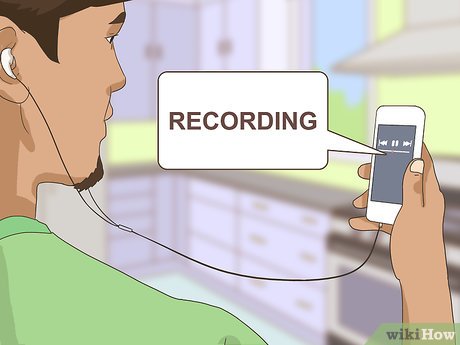How to Develop a 'Radio Voice'
Part 1 of 3:
Practicing Your Radio Voice
-
 Exercise your vocal cords. Develop a powerful voice by practicing strength training for your voice. Choose words with specific sounds, and repeat them going up and down the octaves of your vocal range. Repeat them again at a louder volume.[1]
Exercise your vocal cords. Develop a powerful voice by practicing strength training for your voice. Choose words with specific sounds, and repeat them going up and down the octaves of your vocal range. Repeat them again at a louder volume.[1]- Try repeating, 'Mm-mmm. Mmm-hmm.'
- Try repeating, 'Nay, nay, nay' ten times.
- Try making a siren sound using vowels up and down your vocal range.
- Broadcasters use their vocal cords quickly and with well-controlled tension.[2]
-
 Enunciate your words. Look in the mirror and practice saying each word slowly and properly. Don't mumble.[3] Practice saying tongue-twisters at a rapid pace. Improve your speech quality and it will be easier for you to enunciate live at a faster pace.[4]
Enunciate your words. Look in the mirror and practice saying each word slowly and properly. Don't mumble.[3] Practice saying tongue-twisters at a rapid pace. Improve your speech quality and it will be easier for you to enunciate live at a faster pace.[4]- Try repeating, 'Betty Botter bought a bit of butter' six times.
- Try repeating, 'The ragged rascal ran around the ragged rocks' several times.
-
 Listen to your recorded voice. Get to know the qualities of your voice. Evaluate how you handle mistakes and where you can make improvements. Make sure that you aren't dwelling on your mistakes, which will just draw attention to them.[5]
Listen to your recorded voice. Get to know the qualities of your voice. Evaluate how you handle mistakes and where you can make improvements. Make sure that you aren't dwelling on your mistakes, which will just draw attention to them.[5]- For example, if you mispronounce a word, just correct it – if that's necessary for the audience to understand what you meant – and keep going.[6]
Part 2 of 3:
Warming up Your Voice
-
 Hydrate. Drink warm water or tea with a slice of lemon when you get up in the morning and throughout the day. Don't drink a lot of sugar or caffeine, which can have a drying effect on your voice. Avoid milk and dairy products, which encourage mucus production.[7]
Hydrate. Drink warm water or tea with a slice of lemon when you get up in the morning and throughout the day. Don't drink a lot of sugar or caffeine, which can have a drying effect on your voice. Avoid milk and dairy products, which encourage mucus production.[7]- Warm drinks are best, rather than very hot or cold drinks.
- Green apples contain pectin, which can combat phlegm. Try drinking green apple juice or eating a green apple.
-
 Relax your posture. Relax your shoulders, but don't stoop them or slouch. Keep your body erect but relaxed. Do posture exercises if it's hard for you not to slouch.[8]
Relax your posture. Relax your shoulders, but don't stoop them or slouch. Keep your body erect but relaxed. Do posture exercises if it's hard for you not to slouch.[8]- Good posture gives you the best use of your abdominal-diaphragmatic breathing.
- Slouching pressures the rib cage which makes it harder for you to inhale.
-
 Control your breathing. Open a window, if possible, to make the air you're breathing fresher. Breathe deeply into your lungs without raising your shoulders. Take breath into your nose for the count of three, pause, and then exhale in one big breath for a count of eight.[9]
Control your breathing. Open a window, if possible, to make the air you're breathing fresher. Breathe deeply into your lungs without raising your shoulders. Take breath into your nose for the count of three, pause, and then exhale in one big breath for a count of eight.[9] -
 Lubricate your voice with steam. Maintain a humidity level of at least 30% in your work environment. Run a humidifier, if needed.[10] Breathe in steam from a personal steamer (available at drugstores) or a hot shower. Alternately, pour boiling water into a sink basin and inhale the steam.
Lubricate your voice with steam. Maintain a humidity level of at least 30% in your work environment. Run a humidifier, if needed.[10] Breathe in steam from a personal steamer (available at drugstores) or a hot shower. Alternately, pour boiling water into a sink basin and inhale the steam.- Inhaling steam moistens your voice box and can relieve irritation of the vocal folds.
- Don't inhale steam from directly over a pot of boiling water or a stove.
- Try wetting a washcloth in hot water, wringing it out, and breathing through it with your mouth and/or nose.
-
 Relax your jaws. Put the heels of your hands under your cheek bones. Rub the muscles of your face by pressing inwards and down. Let your jaw open itself as you massage your face.[11]
Relax your jaws. Put the heels of your hands under your cheek bones. Rub the muscles of your face by pressing inwards and down. Let your jaw open itself as you massage your face.[11]- Do this a few times to warm up your mouth and lessen tension in your jaw.
- You can also use circular motions to massage your facial muscles.
-
 Hum and buzz your lips. To hum, exhale with a light 'hmmmm' sound at a low octave that's comfortable for you. Do this again, adding an 'ahhh' sound for the second half of the exhale. To buzz your lips, purse them somewhat and vibrate your lips as you breathe out, with your tongue relaxed. Inhale, then trill with your lips again on the exhale.[12]
Hum and buzz your lips. To hum, exhale with a light 'hmmmm' sound at a low octave that's comfortable for you. Do this again, adding an 'ahhh' sound for the second half of the exhale. To buzz your lips, purse them somewhat and vibrate your lips as you breathe out, with your tongue relaxed. Inhale, then trill with your lips again on the exhale.[12]- You can try these exercises at escalating and deescalating pitches.
-
 Trill your tongue. Hold your tongue behind your top teeth. Breath out, vibrating your tongue in the sound of an 'r.' Maintain the sound. Do this at various pitches, without going past your comfort level.[13]
Trill your tongue. Hold your tongue behind your top teeth. Breath out, vibrating your tongue in the sound of an 'r.' Maintain the sound. Do this at various pitches, without going past your comfort level.[13]- This exercise helps your tongue to relax, while stimulating your voice and breath.
-
 Go up and down octaves. Stretch your voice by starting in a low octave and moving upwards using the sound of 'me.' Don't force your range. Instead, use gentleness to broaden your range with each repetition.[14]
Go up and down octaves. Stretch your voice by starting in a low octave and moving upwards using the sound of 'me.' Don't force your range. Instead, use gentleness to broaden your range with each repetition.[14]- Also try this exercise with the sounds 'e' and 'oo.'
Part 3 of 3:
Developing Your Own Vocal Style
-
 Keep your voice natural. Maintain the organic tone of a conversation. Read written words in a relaxed manner to appeal to the listener. Avoid overly formal speech. Imagine that you are reading aloud to yourself or talking to someone one-on-one. Bring the words to life like you're telling a story.[15]
Keep your voice natural. Maintain the organic tone of a conversation. Read written words in a relaxed manner to appeal to the listener. Avoid overly formal speech. Imagine that you are reading aloud to yourself or talking to someone one-on-one. Bring the words to life like you're telling a story.[15]- Casey Kasem gave the advice to imagine your microphone is an elegant violin that you wish to play with as much feeling as you can.
-
 Don't drop off at the end of a sentence or thought. Express your ideas and statements strongly throughout. Don't trail off, leaving an idea unfinished. Keep a consistent focus and volume.[16]
Don't drop off at the end of a sentence or thought. Express your ideas and statements strongly throughout. Don't trail off, leaving an idea unfinished. Keep a consistent focus and volume.[16]- For instance, don't use all of your air until it's necessary for you to take a breath. Pause your sentence to quickly inhale, then continue speaking.[17]
-
 Be authentic. Focus on sounding like you. Don't try to pigeonhole yourself to satisfy a stereotype, such as by intentionally enhancing your dialect to match a region, age, race or religion. Be sincere and people will want to listen to you, more than if you presented them with a purposefully inauthentic version of you.[18]
Be authentic. Focus on sounding like you. Don't try to pigeonhole yourself to satisfy a stereotype, such as by intentionally enhancing your dialect to match a region, age, race or religion. Be sincere and people will want to listen to you, more than if you presented them with a purposefully inauthentic version of you.[18]- You may have broadcasters you admire, but don't try to sound like someone else. Your uniqueness is what can set you apart.
- Use the voice you hear in your head when you're reading a story to yourself.
-
 Connect with your audience. Research news and current topics of interest. Prepare talking points and notes. Talk about what you think your audience would want to discuss, more than what you want to talk about.[19]
Connect with your audience. Research news and current topics of interest. Prepare talking points and notes. Talk about what you think your audience would want to discuss, more than what you want to talk about.[19]- You can find hot topics by looking online at trending information, and observing what listeners call and write in about.
4.5 ★ | 2 Vote
You should read it
- Mozilla launched the first open source voice recognition engine
- How to Research a Topic
- Fake Voice 7.0 - Download Fake Voice 7.0 here
- Microsoft upgraded Bing's voice recognition capabilities
- Top 15 applications to 'transform' your voice on iPhone
- 5 real-time voice changing software for Discord, Skype, Steam
- How to Cite a Blog in APA
- How to Be a Good Ventriloquist
May be interested
- Fake Voice 7.0 - Download Fake Voice 7.0 here
 fake voice is a software that changes your voice to male, female, old, young, shrill or another type of voice.
fake voice is a software that changes your voice to male, female, old, young, shrill or another type of voice. - Voice over the internet: 10 reasons!
 the reason to switch to using voice over internet protocol (voip) can be raised a lot, depending on whether you want to develop your business model and operations.
the reason to switch to using voice over internet protocol (voip) can be raised a lot, depending on whether you want to develop your business model and operations. - Top 15 applications to 'transform' your voice on iPhone
 are you trying to pretend to be someone else to troll your friends or just to see how your voice is changed, then look at the following voice changing apps on the iphone!
are you trying to pretend to be someone else to troll your friends or just to see how your voice is changed, then look at the following voice changing apps on the iphone! - 5 real-time voice changing software for Discord, Skype, Steam
 do you want your voice like lucifier or satan when playing games? the best way to tease others online is to hide your voice, fake a childish voice or any voice. these voice-changing software are ideal for 'hoaxing' players in online games.
do you want your voice like lucifier or satan when playing games? the best way to tease others online is to hide your voice, fake a childish voice or any voice. these voice-changing software are ideal for 'hoaxing' players in online games. - How to Exercise Your Voice
 if your profession requires you to speak or sing a lot, then you may find that your voice becomes tired very easily. by exercising your voice beforehand, you may be able to strengthen your speaking or singing voice. warm up your voice by...
if your profession requires you to speak or sing a lot, then you may find that your voice becomes tired very easily. by exercising your voice beforehand, you may be able to strengthen your speaking or singing voice. warm up your voice by... - Object from unknown location continuously emitting radio waves
 the object sgr 0501+4516 is so strange that scientists believe it may hold the secret to the phenomenon of radio bursts.
the object sgr 0501+4516 is so strange that scientists believe it may hold the secret to the phenomenon of radio bursts. - 22 unexplained radio signals caught from 'stellar graveyard'
 an observatory in canada has picked up explosive radio signals coming from an 11 billion-year-old world 'rising from the grave'.
an observatory in canada has picked up explosive radio signals coming from an 11 billion-year-old world 'rising from the grave'. - 14 voice changing software for Discord, Skype, Steam
 do you want your voice to sound like lucifier or satan when playing games? the best way to prank others online is to hide your voice, pretend to be a child's voice or any other voice. these voice changing software are ideal for 'pranking' players in online games.
do you want your voice to sound like lucifier or satan when playing games? the best way to prank others online is to hide your voice, pretend to be a child's voice or any other voice. these voice changing software are ideal for 'pranking' players in online games. - 3 ways to listen to the radio via Ubuntu Terminal
 in this article, tipsmake.com will describe 3 tools through which you can listen to online radio from your linux terminal.
in this article, tipsmake.com will describe 3 tools through which you can listen to online radio from your linux terminal. - How to listen to the radio on Windows 10 with Moon FM
 moon fm radio or podcast application on windows 10 with many unique channels.
moon fm radio or podcast application on windows 10 with many unique channels.

























 How to Cut a Picture Mat
How to Cut a Picture Mat How to Go to a Concert if You Are a Teenager
How to Go to a Concert if You Are a Teenager How to Promote Your Music
How to Promote Your Music How to Write an Art Exhibition Review
How to Write an Art Exhibition Review How to Find Inspiration to Write Songs
How to Find Inspiration to Write Songs How to Ask Your Parents to Let You Go to a Concert
How to Ask Your Parents to Let You Go to a Concert